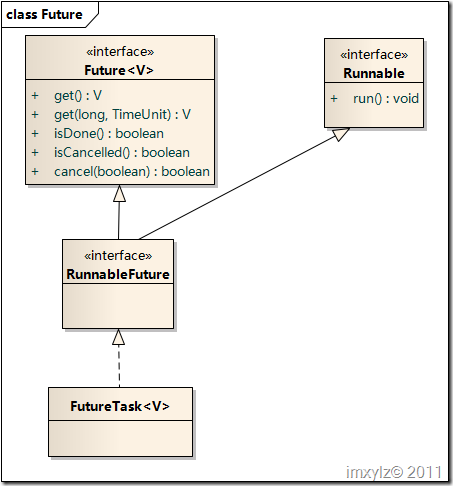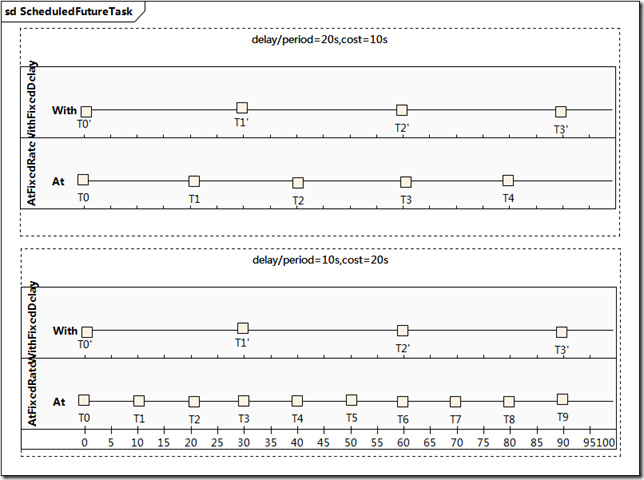[本文地址:http://www.blogjava.net/Files/xylz/Inside.Java.Concurrency_35.ThreadPool.part8_Future.ScheduledThreadPoolExecutor.pdf]
线程池任务执行结果
这一节来探讨下线程池中任务执行的结果以及如何阻塞线程、取消任务等等。
1 package info.imxylz.study.concurrency.future;
2
3 public class SleepForResultDemo implements Runnable {
4
5 static boolean result = false;
6
7 static void sleepWhile(long ms) {
8 try {
9 Thread.sleep(ms);
10 } catch (Exception e) {}
11 }
12
13 @Override
14 public void run() {
15 //do work
16 System.out.println("Hello, sleep a while.");
17 sleepWhile(2000L);
18 result = true;
19 }
20
21 public static void main(String[] args) {
22 SleepForResultDemo demo = new SleepForResultDemo();
23 Thread t = new Thread(demo);
24 t.start();
25 sleepWhile(3000L);
26 System.out.println(result);
27 }
28
29 }
30
在没有线程池的时代里面,使用Thread.sleep(long)去获取线程执行完毕的场景很多。显然这种方式很笨拙,他需要你事先知道任务可能的执行时间,并且还会阻塞主线程,不管任务有没有执行完毕。
1 package info.imxylz.study.concurrency.future;
2
3 public class SleepLoopForResultDemo implements Runnable {
4
5 boolean result = false;
6
7 volatile boolean finished = false;
8
9 static void sleepWhile(long ms) {
10 try {
11 Thread.sleep(ms);
12 } catch (Exception e) {}
13 }
14
15 @Override
16 public void run() {
17 //do work
18 try {
19 System.out.println("Hello, sleep a while.");
20 sleepWhile(2000L);
21 result = true;
22 } finally {
23 finished = true;
24 }
25 }
26
27 public static void main(String[] args) {
28 SleepLoopForResultDemo demo = new SleepLoopForResultDemo();
29 Thread t = new Thread(demo);
30 t.start();
31 while (!demo.finished) {
32 sleepWhile(10L);
33 }
34 System.out.println(demo.result);
35 }
36
37 }
38
使用volatile与while死循环的好处就是等待的时间可以稍微小一点,但是依然有CPU负载高并且阻塞主线程的问题。最简单的降低CPU负载的方式就是使用Thread.join().
SleepLoopForResultDemo demo = new SleepLoopForResultDemo();
Thread t = new Thread(demo);
t.start();
t.join();
System.out.println(demo.result);
显然这也是一种不错的方式,另外还有自己写锁使用wait/notify的方式。其实join()从本质上讲就是利用while和wait来实现的。
上面的方式中都存在一个问题,那就是会阻塞主线程并且任务不能被取消。为了解决这个问题,线程池中提供了一个Future接口。

在Future接口中提供了5个方法。
- V get() throws InterruptedException, ExecutionException: 等待计算完成,然后获取其结果。
- V get(long timeout, TimeUnit unit) throws InterruptedException, ExecutionException, TimeoutException。最多等待为使计算完成所给定的时间之后,获取其结果(如果结果可用)。
- boolean cancel(boolean mayInterruptIfRunning):试图取消对此任务的执行。
- boolean isCancelled():如果在任务正常完成前将其取消,则返回 true。
- boolean isDone():如果任务已完成,则返回 true。 可能由于正常终止、异常或取消而完成,在所有这些情况中,此方法都将返回 true。
API看起来容易,来研究下异常吧。get()请求获取一个结果会阻塞当前进程,并且可能抛出以下三种异常:
- InterruptedException:执行任务的线程被中断则会抛出此异常,此时不能知道任务是否执行完毕,因此其结果是无用的,必须处理此异常。
- ExecutionException:任务执行过程中(Runnable#run())方法可能抛出RuntimeException,如果提交的是一个java.util.concurrent.Callable<V>接口任务,那么java.util.concurrent.Callable.call()方法有可能抛出任意异常。
- CancellationException:实际上get()方法还可能抛出一个CancellationException的RuntimeException,也就是任务被取消了但是依然去获取结果。
对于get(long timeout, TimeUnit unit)而言,除了get()方法的异常外,由于有超时机制,因此还可能得到一个TimeoutException。
boolean cancel(boolean mayInterruptIfRunning)方法比较复杂,各种情况比较多:
- 如果任务已经执行完毕,那么返回false。
- 如果任务已经取消,那么返回false。
- 循环直到设置任务为取消状态,对于未启动的任务将永远不再执行,对于正在运行的任务,将根据mayInterruptIfRunning是否中断其运行,如果不中断那么任务将继续运行直到结束。
- 此方法返回后任务要么处于运行结束状态,要么处于取消状态。isDone()将永远返回true,如果cancel()方法返回true,isCancelled()始终返回true。
来看看Future接口的实现类java.util.concurrent.FutureTask<V>具体是如何操作的。
在FutureTask中使用了一个AQS数据结构来完成各种状态以及加锁、阻塞的实现。
在此AQS类java.util.concurrent.FutureTask.Sync中一个任务用4中状态:

初始情况下任务状态state=0,任务执行(innerRun)后状态变为运行状态RUNNING(state=1),执行完毕后变成运行结束状态RAN(state=2)。任务在初始状态或者执行状态被取消后就变为状态CANCELLED(state=4)。AQS最擅长无锁情况下处理几种简单的状态变更的。
void innerRun() {
if (!compareAndSetState(0, RUNNING))
return;
try {
runner = Thread.currentThread();
if (getState() == RUNNING) // recheck after setting thread
innerSet(callable.call());
else
releaseShared(0); // cancel
} catch (Throwable ex) {
innerSetException(ex);
}
}
执行一个任务有四步:设置运行状态、设置当前线程(AQS需要)、执行任务(Runnable#run或者Callable#call)、设置执行结果。这里也可以看到,一个任务只能执行一次,因为执行完毕后它的状态不在为初始值0,要么为CANCELLED,要么为RAN。
取消一个任务(cancel)又是怎样进行的呢?对比下前面取消任务的描述是不是很简单,这里无非利用AQS的状态来改变任务的执行状态,最终达到放弃未启动或者正在执行的任务的目的。
boolean innerCancel(boolean mayInterruptIfRunning) {
for (;;) {
int s = getState();
if (ranOrCancelled(s))
return false;
if (compareAndSetState(s, CANCELLED))
break;
}
if (mayInterruptIfRunning) {
Thread r = runner;
if (r != null)
r.interrupt();
}
releaseShared(0);
done();
return true;
}
到目前为止我们依然没有说明到底是如何阻塞获取一个结果的。下面四段代码描述了这个过程。
1 V innerGet() throws InterruptedException, ExecutionException {
2 acquireSharedInterruptibly(0);
3 if (getState() == CANCELLED)
4 throw new CancellationException();
5 if (exception != null)
6 throw new ExecutionException(exception);
7 return result;
8 }
9 //AQS#acquireSharedInterruptibly
10 public final void acquireSharedInterruptibly(int arg) throws InterruptedException {
11 if (Thread.interrupted())
12 throw new InterruptedException();
13 if (tryAcquireShared(arg) < 0)
14 doAcquireSharedInterruptibly(arg); //park current Thread for result
15 }
16 protected int tryAcquireShared(int ignore) {
17 return innerIsDone()? 1 : -1;
18 }
19
20 boolean innerIsDone() {
21 return ranOrCancelled(getState()) && runner == null;
22 }
当调用Future#get()的时候尝试去获取一个共享变量。这就涉及到AQS的使用方式了。这里获取一个共享变量的状态是任务是否结束(innerIsDone()),也就是任务是否执行完毕或者被取消。如果不满足条件,那么在AQS中就会doAcquireSharedInterruptibly(arg)挂起当前线程,直到满足条件。AQS前面讲过,挂起线程使用的是LockSupport的park方式,因此性能消耗是很低的。
至于将Runnable接口转换成Callable接口,java.util.concurrent.Executors.callable(Runnable, T)也提供了一个简单实现。
static final class RunnableAdapter<T> implements Callable<T> {
final Runnable task;
final T result;
RunnableAdapter(Runnable task, T result) {
this.task = task;
this.result = result;
}
public T call() {
task.run();
return result;
}
}
延迟、周期性任务调度的实现
java.util.concurrent.ScheduledThreadPoolExecutor是默认的延迟、周期性任务调度的实现。
有了整个线程池的实现,再回头来看延迟、周期性任务调度的实现应该就很简单了,因为所谓的延迟、周期性任务调度,无非添加一系列有序的任务队列,然后按照执行顺序的先后来处理整个任务队列。如果是周期性任务,那么在执行完毕的时候加入下一个时间点的任务即可。
由此可见,ScheduledThreadPoolExecutor和ThreadPoolExecutor的唯一区别在于任务是有序(按照执行时间顺序)的,并且需要到达时间点(临界点)才能执行,并不是任务队列中有任务就需要执行的。也就是说唯一不同的就是任务队列BlockingQueue<Runnable> workQueue不一样。ScheduledThreadPoolExecutor的任务队列是java.util.concurrent.ScheduledThreadPoolExecutor.DelayedWorkQueue,它是基于java.util.concurrent.DelayQueue<RunnableScheduledFuture>队列的实现。
DelayQueue是基于有序队列PriorityQueue实现的。PriorityQueue 也叫优先级队列,按照自然顺序对元素进行排序,类似于TreeMap/Collections.sort一样。
同样是有序队列,DelayQueue和PriorityQueue区别在什么地方?
由于DelayQueue在获取元素时需要检测元素是否“可用”,也就是任务是否达到“临界点”(指定时间点),因此加入元素和移除元素会有一些额外的操作。
典型的,移除元素需要检测元素是否达到“临界点”,增加元素的时候如果有一个元素比“头元素”更早达到临界点,那么就需要通知任务队列。因此这需要一个条件变量final Condition available 。
移除元素(出队列)的过程是这样的:
- 总是检测队列的头元素(顺序最小元素,也是最先达到临界点的元素)
- 检测头元素与当前时间的差,如果大于0,表示还未到底临界点,因此等待响应时间(使用条件变量available)
- 如果小于或者等于0,说明已经到底临界点或者已经过了临界点,那么就移除头元素,并且唤醒其它等待任务队列的线程。
public E take() throws InterruptedException {
final ReentrantLock lock = this.lock;
lock.lockInterruptibly();
try {
for (;;) {
E first = q.peek();
if (first == null) {
available.await();
} else {
long delay = first.getDelay(TimeUnit.NANOSECONDS);
if (delay > 0) {
long tl = available.awaitNanos(delay);
} else {
E x = q.poll();
assert x != null;
if (q.size() != 0)
available.signalAll(); // wake up other takers
return x;
}
}
}
} finally {
lock.unlock();
}
}
同样加入元素也会有相应的条件变量操作。当前仅当队列为空或者要加入的元素比队列中的头元素还小的时候才需要唤醒“等待线程”去检测元素。因为头元素都没有唤醒那么比头元素更延迟的元素就更加不会唤醒。
public boolean offer(E e) {
final ReentrantLock lock = this.lock;
lock.lock();
try {
E first = q.peek();
q.offer(e);
if (first == null || e.compareTo(first) < 0)
available.signalAll();
return true;
} finally {
lock.unlock();
}
}
有了任务队列后再来看Future在ScheduledThreadPoolExecutor中是如何操作的。
java.util.concurrent.ScheduledThreadPoolExecutor.ScheduledFutureTask<V>是继承java.util.concurrent.FutureTask<V>的,区别在于执行任务是否是周期性的。
private void runPeriodic() {
boolean ok = ScheduledFutureTask.super.runAndReset();
boolean down = isShutdown();
// Reschedule if not cancelled and not shutdown or policy allows
if (ok && (!down ||
(getContinueExistingPeriodicTasksAfterShutdownPolicy() &&
!isStopped()))) {
long p = period;
if (p > 0)
time += p;
else
time = now() - p;
ScheduledThreadPoolExecutor.super.getQueue().add(this);
}
// This might have been the final executed delayed
// task. Wake up threads to check.
else if (down)
interruptIdleWorkers();
}
/**
* Overrides FutureTask version so as to reset/requeue if periodic.
*/
public void run() {
if (isPeriodic())
runPeriodic();
else
ScheduledFutureTask.super.run();
}
}
如果不是周期性任务调度,那么就和java.util.concurrent.FutureTask.Sync的调度方式是一样的。如果是周期性任务(isPeriodic())那么就稍微有所不同的。

先从功能/结构上分析下。第一种情况假设提交的任务每次执行花费10s,间隔(delay/period)为20s,对于scheduleAtFixedRate而言,每次执行开始时间20s,对于scheduleWithFixedDelay来说每次执行开始时间30s。第二种情况假设提交的任务每次执行时间花费20s,间隔(delay/period)为10s,对于scheduleAtFixedRate而言,每次执行开始时间10s,对于scheduleWithFixedDelay来说每次执行开始时间30s。(具体分析可以参考这里)
也就是说scheduleWithFixedDelay的执行开始时间为(delay+cost),而对于scheduleAtFixedRate来说执行开始时间为max(period,cost)。
回头再来看上面源码runPeriodic()就很容易了。但特别要提醒的,如果任务的任何一个执行遇到异常,则后续执行都会被取消,这从runPeriodic()就能看出。要强调的第二点就是同一个周期性任务不会被同时执行。就比如说尽管上面第二种情况的scheduleAtFixedRate任务每隔10s执行到达一个时间点,但是由于每次执行时间花费为20s,因此每次执行间隔为20s,只不过执行的任务次数会多一点。但从本质上讲就是每隔20s执行一次,如果任务队列不取消的话。
为什么不会同时执行?
这是因为ScheduledFutureTask执行的时候会将任务从队列中移除来,执行完毕以后才会添加下一个同序列的任务,因此任务队列中其实最多只有同序列的任务的一份副本,所以永远不会同时执行(尽管要执行的时间在过去)。
ScheduledThreadPoolExecutor使用一个无界(容量无限,整数的最大值)的容器(DelayedWorkQueue队列),根据ThreadPoolExecutor的原理,只要当容器满的时候才会启动一个大于corePoolSize的线程数。因此实际上ScheduledThreadPoolExecutor是一个固定线程大小的线程池,固定大小为corePoolSize,构造函数里面的Integer.MAX_VALUE其实是不生效的(尽管PriorityQueue使用数组实现有PriorityQueue大小限制,如果你的任务数超过了2147483647就会导致OutOfMemoryError,这个参考PriorityQueue的grow方法)。
再回头看scheduleAtFixedRate等方法就容易多了。无非就是往任务队列中添加一个未来某一时刻的ScheduledFutureTask任务,如果是scheduleAtFixedRate那么period/delay就是正数,如果是scheduleWithFixedDelay那么period/delay就是一个负数,如果是0那么就是一次性任务。直接调用父类ThreadPoolExecutor的execute/submit等方法就相当于period/delay是0,并且initialDelay也是0。
public ScheduledFuture<?> scheduleAtFixedRate(Runnable command,
long initialDelay,
long period,
TimeUnit unit) {
if (command == null || unit == null)
throw new NullPointerException();
if (period <= 0)
throw new IllegalArgumentException();
if (initialDelay < 0) initialDelay = 0;
long triggerTime = now() + unit.toNanos(initialDelay);
RunnableScheduledFuture<?> t = decorateTask(command,
new ScheduledFutureTask<Object>(command,
null,
triggerTime,
unit.toNanos(period)));
delayedExecute(t);
return t;
}
另外需要补充说明的一点,前面说过java.util.concurrent.FutureTask.Sync任务只能执行一次,那么在runPeriodic()里面怎么又将执行过的任务加入队列中呢?这是因为java.util.concurrent.FutureTask.Sync提供了一个innerRunAndReset()方法,此方法不仅执行任务还将任务的状态还原成0(初始状态)了,所以此任务就可以重复执行。这就是为什么runPeriodic()里面调用runAndRest()的缘故。
boolean innerRunAndReset() {
if (!compareAndSetState(0, RUNNING))
return false;
try {
runner = Thread.currentThread();
if (getState() == RUNNING)
callable.call(); // don't set result
runner = null;
return compareAndSetState(RUNNING, 0);
} catch (Throwable ex) {
innerSetException(ex);
return false;
}
}
后话
整个并发实践原理和实现(源码)上的东西都讲完了,后面几个小节是一些总结和扫尾的工作,包括超时机制、异常处理等一些细节问题。也就是说大部分只需要搬出一些理论和最佳实践知识出来就好了,不会有大量费脑筋的算法分析和原理、思想探讨之类的。后面的章节也会加快一些进度。
老实说从刚开始的好奇到中间的兴奋,再到现在的彻悟,收获还是很多,个人觉得这是最认真、最努力也是自我最满意的一次技术研究和探讨,同时在这个过程中将很多技术细节都串联起来了,慢慢就有了那种技术相通的感觉。原来有了理论以后再去实践、再去分析问题、解决问题和那种纯解决问题得到的经验完全不一样。整个专辑下来不仅仅是并发包这一点点知识,设计到硬件、软件、操作系统、网络、安全、性能、算法、理论等等,总的来说这也算是一次比较成功的研究切入点,这比Guice那次探讨要深入和持久的多。
--
©2009-2014 IMXYLZ
|求贤若渴